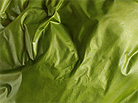Bartosz Kokosiński — ‘Some pictures do not want to be painted’
‘Inessentials’ — book summary of exhibition cycles The project ‘Inessentials’, which is planned for the whole year, involving artists, designers and the local community in a series of...

Małgorzata Szymankiewicz — ‘Low visibility’ in ‘small space’ En eye should be quick and good. There is no time for raising eyebrows, for closing eyelids – it might be too late. In past times one needed time for a...

Karolina Żyniewicz — ‘Fear of Darkness’ — within the framework of Biennial of Art for Children When Karolina Żyniewicz organises space, she doesn't clearly mark the focal point. The objects are laid out and hung in accordance with her own geometric...

Maciej Nawrot — ‘Days go by in a rush like wild horses from a hill’ I decided to paint it, says Maciek. We can feel that something can happen within certain selected frames, but we are still not sure whether we are in the right...

Bartosz Kokosiński's most recent paintings look as if something has just wriggled under their surface, stretching the canvas and disfiguring the frames with its shape and weight. The matter which the artist wanted to appropriate mounted resistance, flipping like a fish entangled in a net. Whatever it was, after this brief struggle the creature managed to wrestle out of the safe cocoon of the picture, leaving behind the sagging, rumpled canvas.
Kokosiński seems to highlight the inherent weaknesses of painting: creative crises, mistakes, impossibility and deficiency. On the other hand, he employs mechanisms that govern iconoclastic fear, caused by conceptions which weigh more than the reality itself — they constitute its essence. How much of an object, event or person that has been painted (divinity) remains in the picture? Would we like pictures to live, to show dangerous and ominous Something, or would we prefer unwanted Nothing? The artist-hero protects us from whatever could crawl out from under the canvas, at the same time revealing the dramatic struggle, whose traces remain in the picture. He directs the viewer's attention to the aggression that accompanies creative processes: copying, playing back, borrowing. In some cycles this cannibalistic aspect is extremely blunt. “Pictures which devour reality”, closing their jaws on the classical sets of still lifes, snapping shut like suitcases.
Marta Lisok
Curator









